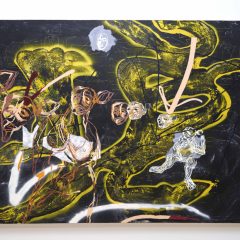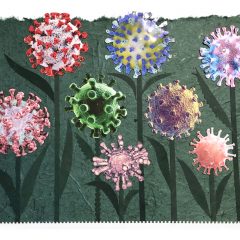
Art is a particular kind of self-indulgent activity that encourages an artist to play with their own personal fires. Two shows I saw last weekend reminded me of how personal obsessions and the art explorations that go with them are a good thing. While one artist’s obsessions may seem off point to an audience of non-like-minded viewers if there’s enough there there you’ll find a way in to the work. And if you do It’s like having a conversation with someone from another culture –there is a way to bridge the gap.
The Ghosts that Haunt Us

Tyler Kline’s installation at Little Berlin.
So here we have Tyler Kline‘s The Ghosts that Haunt Us, just closed at Little Berlin, an obsessive romp focused on things like past and present relationships that take place over long distances and large timespans. There is a gorgeous aluminum skull in the installation that spoke to me of longing and loss. Inkblots on small pieces of paper sat like a butterfly infestation on one wall (I remember the Monarch butterflies that migrate down the West Coast–flocks so delicate the journey seems impossible). Prints of a bridge and a dumpster are generic urban connectors no matter what specific grafitti from a specific town is on them. And on the walls, lines in grey that seem to reach out and connect it all;
Kline’s exploration of ghosts and the idea of unstated, unseen connections sprawled through two rooms, ceiling to floor, and gave the impression of stepping into the mind of the artist. The installation had non-linear logic and, like synapses firing at will, the scenery changed snap, snap, snap while the central idea (connections between people, places and things) stayed constant. Kline, (see Andrea’s post for more) included work by his friend Mike McGovern, with whom he feels a strong connection over time and place. Consider the show a collaboration of sorts between Kline and the spirit of McGovern.
I loved much of the individual moments in the big installation. There were paintings on walls, paintings on vinyl records, prints in grids, aluminum foil sculptures, and, one of my favorites — a wall (actually there were two) of Polaroid snapshots. Kline has a great eye and the shots were like windows into another time and place — or embedded memories in a mind’s data bank waiting to be retrieved..

Tyler Kline, wall of Polaroids.
Kline, who moved here three years ago from Portland, OR, and works as a conservationist for the Conservation Center, told me he was having an exhibit in the Crane in the inliquid hallway outside Nexus next November. The artist and new father (his toddler son appears in the installation in various drawings, photos and paintings) is someone who grew up in one place, spent college and post-college in another and is now living in a third — a lot of cross-country uprooting for a young person. The spatial dislocation is enough to make you obsess over connections lost and connections kept and what it all means.
M-Class Planet

Keary Rosen. Mars Rover, 22x17x33. 1920s Toledo Candy Scale, steel, auto-body paint, photo, motor, skateboard truck, training wheels, chain, remote control. 2008
Keary Rosen‘s M-Class Planet at Jaskey/Tower (open through Friday, April 25) is one man channeling his love for and fascination with robots, droids and science fiction. M-Class Planet is a spare installation of drawings, robots and two videos embedded in a sleek red viewing station. Its taut understatement compelled attention.
The objects are precise and beautiful. The Mars Rover, tethered to a chain and allowed to circle the gallery when activated by remote control, has a funny lilt to it. Made from low tech non-robot materials the little Rover didn’t so much rove as lurch — an up-from-the-basement machine with aspirations. It reminded me that movies about outer space — which seem high tech and full of whiz bang — are made with many such juryrigged objects pretending to be what they’re not. Rosen has inserted himself into this narrative non-narrative show. He is the robot Mars Rover, he is the automaton playing the string base. It’s the physical manifestation of the story we all have–putting ourselves into someone else’s narrative just to see how we fit. I understand it, have done it in my own imagination and just love it that Rosen has bared his soul here in this work, which is wry and a little self-mocking but also earnest and child-like.

Keary Rosen at Jaskey/Tower. The Two Man Jug Band. 72x72x68″.
The robot: 1937 Electrolux vacuum cleaner. steel, autobody paint, rubber, flexible lamp arms, industrial machine feet, antique maple syrup jug.
The man: Raku clay, steel, motor. 19th Century Early Victorial Civilian Men’s Clothing and Boots, galvanized steel wash tub, broom stick, rubber, stereo.
Both shows are fascinating expositions on how to run with an idea and make it work in a large gallery. And both played out their obsessions with individuality and a coherent world view. Both installations communicated such human stories (Kline’s about connecting; Rosen’s about imagination) in such idiosyncratic ways — that while I knew nothing at first about the particulars of each artist’s story-line, I was nonetheless charmed and entertained by both.









